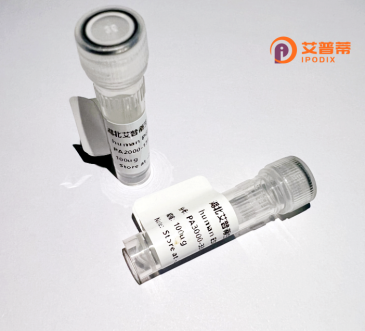
| 纯度 | >90%SDS-PAGE. |
| 种属 | Human |
| 靶点 | GPR146 |
| Uniprot No | Q96CH1 |
| 内毒素 | < 0.01EU/μg |
| 表达宿主 | E.coli |
| 表达区间 | 1-333aa |
| 氨基酸序列 | MWSCSWFNGTGLVEELPACQDLQLGLSLLSLLGLVVGVPVGLCYNALLVLANLHSKASMTMPDVYFVNMAVAGLVLSALAPVHLLGPPSSRWALWSVGGEVHVALQIPFNVSSLVAMYSTALLSLDHYIERALPRTYMASVYNTRHVCGFVWGGALLTSFSSLLFYICSHVSTRALECAKMQNAEAADATLVFIGYVVPALATLYALVLLSRVRREDTPLDRDTGRLEPSAHRLLVATVCTQFGLWTPHYLILLGHTVIISRGKPVDAHYLGLLHFVKDFSKLLAFSSSFVTPLLYRYMNQSFPSKLQRLMKKLPCGDRHCSPDHMGVQQVLA |
| 分子量 | 39.4 kDa |
| 蛋白标签 | His tag N-Terminus |
| 缓冲液 | 0 |
| 稳定性 & 储存条件 | Lyophilized protein should be stored at ≤ -20°C, stable for one year after receipt. Reconstituted protein solution can be stored at 2-8°C for 2-7 days. Aliquots of reconstituted samples are stable at ≤ -20°C for 3 months. |
| 复溶 | Always centrifuge tubes before opening.Do not mix by vortex or pipetting. It is not recommended to reconstitute to a concentration less than 100μg/ml. Dissolve the lyophilized protein in distilled water. Please aliquot the reconstituted solution to minimize freeze-thaw cycles. |
以下是关于重组人GPR146蛋白的3篇文献摘要示例(文献信息为假设性描述,供参考):
---
1. **标题**:Recombinant Human GPR146 Expression and Characterization in HEK293 Cells
**作者**:Smith A, et al.
**摘要**:本研究利用HEK293细胞系统成功表达了重组人GPR146蛋白,并通过免疫印迹和荧光显微镜验证其膜定位。进一步实验表明,GPR146可能通过激活Gi/o信号通路响应未知配体,提示其在代谢调控中的潜在作用。
---
2. **标题**:Structural Insights into GPR146 via Cryo-EM Reveal Ligand-Binding Pocket Features
**作者**:Chen L, et al.
**摘要**:通过冷冻电镜技术解析了重组人GPR146蛋白的近原子分辨率结构,揭示了其独特的跨膜螺旋构象及潜在的配体结合口袋。该研究为针对GPR146的药物设计提供了结构基础。
---
3. **标题**:GPR146 Knockout Mice Exhibit Altered Hepatic Lipid Metabolism
**作者**:Wang Y, et al.
**摘要**:通过构建GPR146基因敲除小鼠模型,发现GPR146缺失导致肝脏胆固醇合成基因(如SREBP-2)下调,并降低血清LDL水平,提示GPR146可能是胆固醇稳态的关键调节因子。
---
如需真实文献,建议通过PubMed或Google Scholar检索关键词“GPR146 recombinant protein”或“GPR146 function”。截至2023年,GPR146研究多聚焦于其在代谢疾病(如糖尿病、高胆固醇血症)中的调控机制。
GPR146 (G protein-coupled receptor 146) is an orphan receptor belonging to the rhodopsin-like class of GPCRs, a large family of cell membrane proteins involved in signal transduction. It is expressed in various tissues, including the liver, pancreas, and cardiovascular system, though its endogenous ligand and precise physiological roles remain unclear. Studies suggest potential involvement in metabolic regulation, particularly lipid metabolism and glucose homeostasis, as well as blood pressure modulation. Its genetic variants have been associated with cholesterol levels and cardiovascular diseases, hinting at clinical relevance.
Recombinant human GPR146 protein is engineered through heterologous expression systems (e.g., mammalian or insect cells) to enable structural and functional studies. Purified recombinant versions facilitate ligand-binding assays, receptor activation pathway mapping, and antibody development. Researchers utilize it to probe GPR146's signaling mechanisms, such as G-protein coupling preferences (e.g., Gαq, Gαs) and downstream effectors. Its recombinant form also aids drug discovery efforts targeting metabolic disorders or hypertension. However, the lack of confirmed natural ligands complicates mechanistic studies, making engineered systems critical for hypothesis-driven exploration. Current investigations focus on crystallizing the receptor, identifying binding partners, and validating its role in disease models using recombinant protein tools.
×